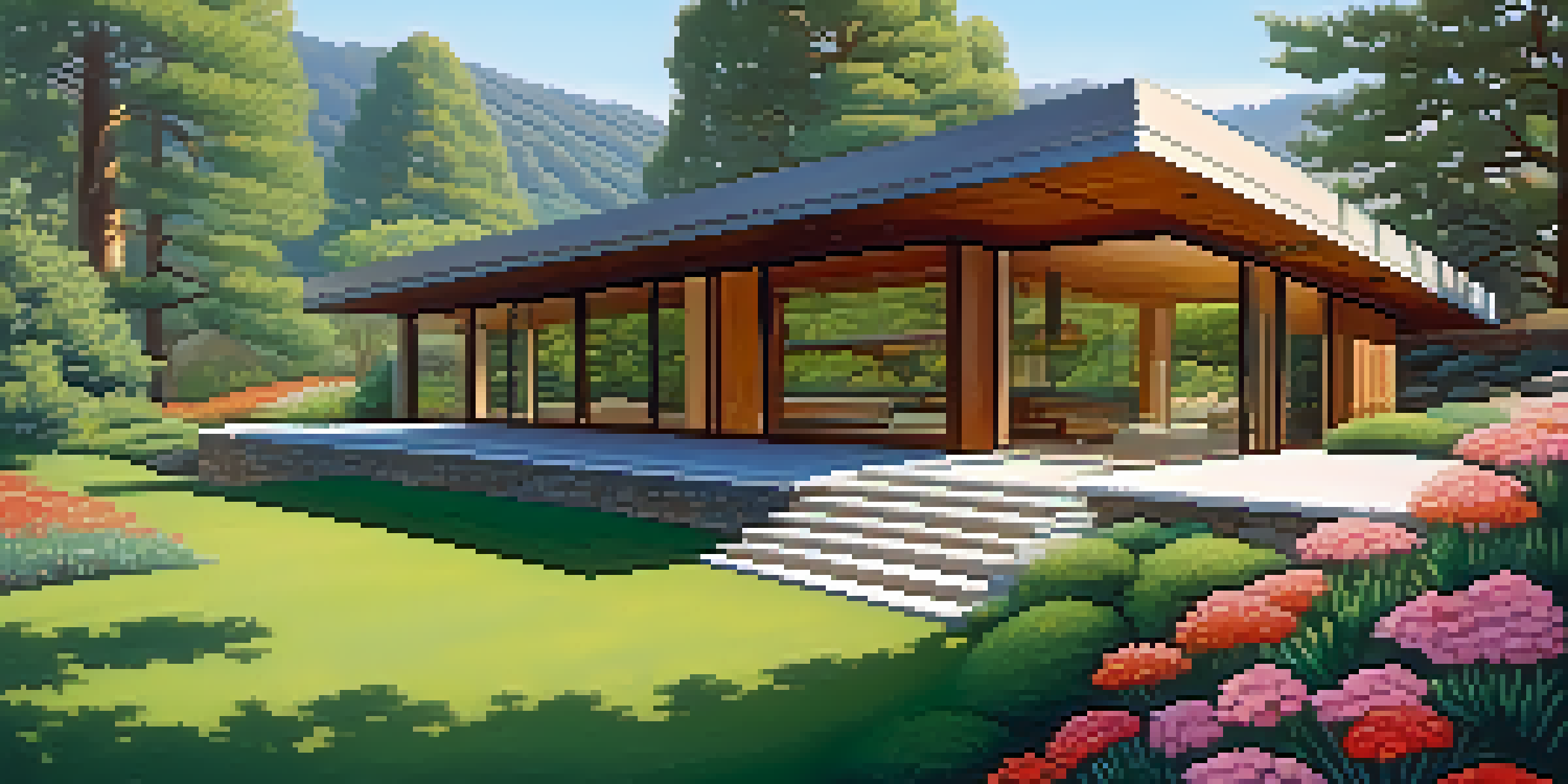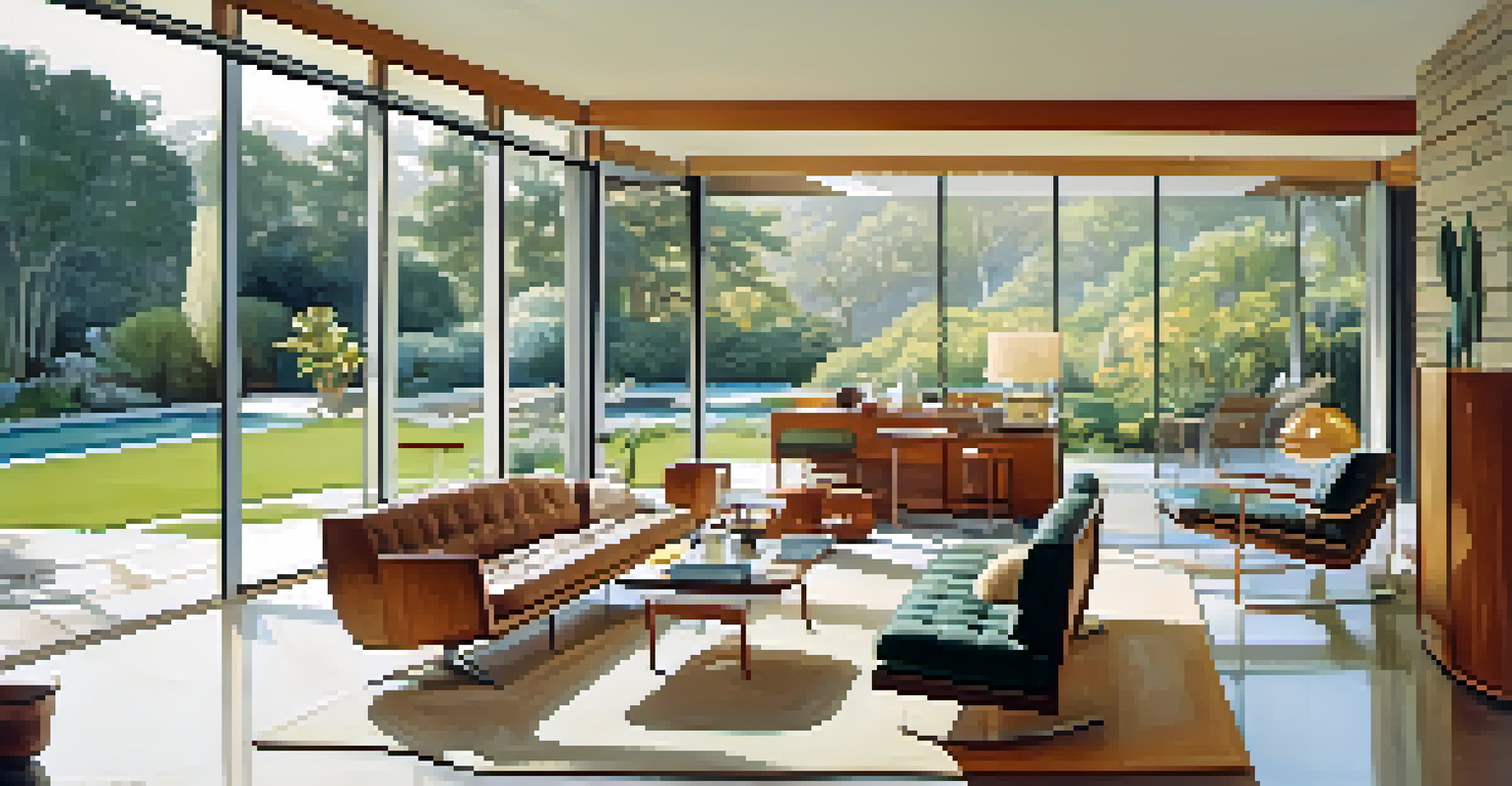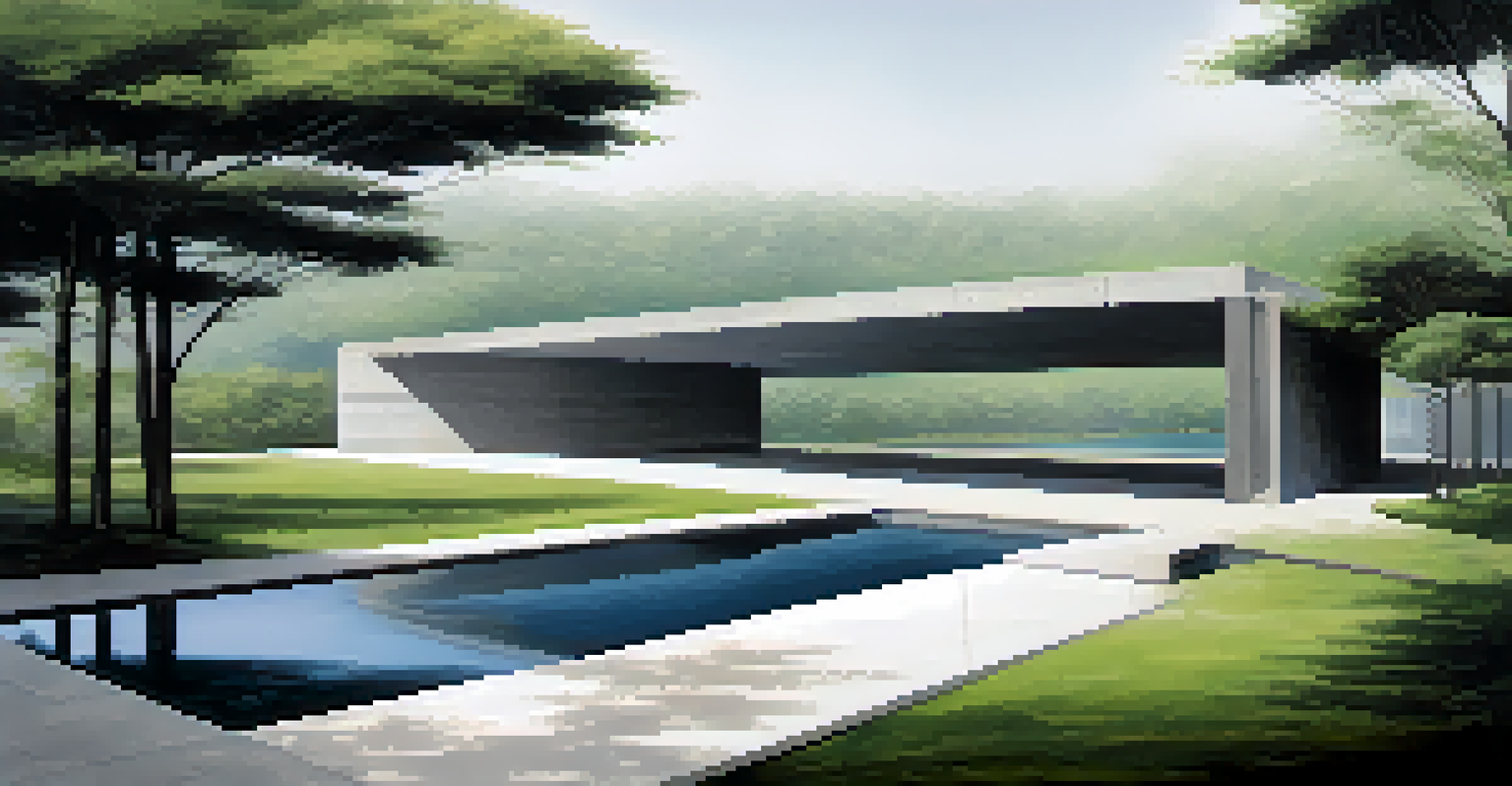Notable Architects Who Defined California's Design Landscape

Frank Lloyd Wright: The Pioneer of Organic Architecture
Frank Lloyd Wright is often celebrated as a pioneer of organic architecture, a style that harmonizes buildings with their natural surroundings. In California, his designs, such as the iconic Hollyhock House, showcase his innovative approach by incorporating local materials and landscapes. Wright's vision was not just about aesthetics; it was about creating a living space that felt like a part of the environment, which resonated deeply with the California ethos of blending indoor and outdoor living.
The mother art is architecture. Without an architecture of our own, we have no soul of our own civilization.
His philosophy of organic architecture emphasized the idea that buildings should be an extension of their landscape, which is evident in many of his Californian works. The use of cantilevered roofs and open floor plans allowed for an abundance of natural light and seamless transitions between spaces. This approach has influenced countless architects who followed, establishing a firm belief in the relationship between architecture and nature.
Wright's legacy in California extends beyond his individual projects; he inspired future generations of architects to consider their designs' impact on the environment. His work laid the groundwork for the modern California style, which celebrates sustainability and the beauty of the natural world. Today, his influence is still palpable in the designs of contemporary architects who continue to push the boundaries of what architecture can achieve.
Richard Neutra: The Master of Modernism
Richard Neutra, an Austrian-American architect, is celebrated for his pivotal role in the modernist movement in California. His work, characterized by clean lines and an emphasis on the relationship between indoor and outdoor spaces, redefined residential architecture in the mid-20th century. Notable examples of his designs include the Kaufmann Desert House and the Lovell Health House, both of which exemplify his integration of modern aesthetics with functional living.

Neutra believed that architecture should enhance the quality of life, and his designs often featured large glass windows and open spaces that invited the surrounding landscape into the home. This philosophy aligned perfectly with California's natural beauty, making his homes feel like extensions of their environments. His innovative use of materials, such as steel and concrete, also exemplified a forward-thinking approach that resonated with the modernist ideals of the time.
California's Architectural Diversity
California's architecture showcases a rich blend of styles influenced by its cultural heritage and innovative spirit.
Beyond his architectural accomplishments, Neutra was known for his emphasis on health and well-being in his designs. He aimed to create spaces that promoted a harmonious lifestyle, reflecting the growing interest in wellness during the post-war era. Today, his work continues to influence architects who strive to create spaces that foster connection, both to nature and to the people who inhabit them.
Julia Morgan: A Trailblazer for Women in Architecture
Julia Morgan holds a distinguished place in California's architectural history as the first woman to be licensed as an architect in the state. Her impressive portfolio includes over 700 projects, with the most famous being the Hearst Castle in San Simeon. Morgan's work is characterized by her attention to detail and her ability to blend different architectural styles, ranging from Gothic Revival to Mediterranean.
The best way to predict the future is to create it.
Morgan's designs often incorporated local materials and craftsmanship, which helped her buildings harmonize with their surroundings. She understood the importance of creating spaces that not only served their functional purpose but also inspired awe and admiration. Her innovative approach to architecture laid the foundation for future female architects, showcasing that women could excel in a field historically dominated by men.
In addition to her architectural achievements, Morgan was committed to social causes, often designing buildings for women's organizations and educational institutions. Her legacy is a testament to her belief in the power of architecture to create positive change in the community. Today, Julia Morgan is celebrated not just for her architectural prowess but also as a symbol of empowerment for women in the field.
Frank Gehry: The Icon of Deconstructivism
Frank Gehry is perhaps one of the most recognizable names in contemporary architecture, known for his distinctive deconstructivist style. His iconic buildings, such as the Walt Disney Concert Hall in Los Angeles, challenge traditional notions of form and structure. Gehry's designs often feature dynamic shapes and unconventional materials, creating a sense of movement and fluidity that captivates onlookers.
Gehry's architectural philosophy emphasizes the importance of artistic expression and individuality. He believes that buildings should evoke emotion and provoke thought, which is evident in his bold, sculptural forms. This approach has not only redefined the architectural landscape of California but has also inspired architects worldwide to think outside the box.
Sustainability in Design
Emerging architects are increasingly prioritizing eco-friendly practices and sustainable materials in their designs.
Moreover, Gehry's work often reflects the cultural and historical context of its location, making his buildings significant landmarks within their communities. His ability to blend art and architecture has led to a new appreciation for how buildings can be both functional and artistic. As a result, Gehry's influence can be seen in a new generation of architects who embrace creativity and innovation in their designs.
Rudolph Schindler: The Innovator of Space
Rudolph Schindler is often credited with pioneering the modernist movement in California, particularly through his innovative use of space and materials. His work, most notably the Schindler House in West Hollywood, broke away from traditional architectural conventions, emphasizing open floor plans and the seamless flow of interior and exterior spaces. This approach was revolutionary at the time and has since influenced countless architects in the region.
Schindler's designs often incorporated elements of nature, promoting a lifestyle that encouraged the blending of indoor and outdoor living. He believed that architecture should respond to the needs of its inhabitants, which is reflected in his flexible, adaptable spaces. This focus on functionality and connection to the environment resonated with California's climate and lifestyle, making his work particularly relevant to the region.
Beyond his architectural innovations, Schindler was also interested in social issues, often designing spaces that fostered community interaction. His work laid the groundwork for the future of residential architecture in California, emphasizing the importance of thoughtful design in creating livable, harmonious spaces. Today, Schindler is remembered as a visionary who reshaped the architectural landscape of California.
Charles and Ray Eames: Pioneers of Modern Design
Charles and Ray Eames were a husband-and-wife team whose contributions to architecture and design are legendary. Their work went beyond traditional architecture, as they sought to create functional, beautiful designs that reflected modern living. The Eames House, located in Pacific Palisades, is a prime example of their innovative approach, blending architecture with art and design seamlessly.
The Eameses believed that design should be accessible to everyone, which is evident in their use of industrial materials and mass production techniques. They created furniture that was not only aesthetically pleasing but also practical, resulting in iconic pieces like the Eames Lounge Chair that are still celebrated today. Their philosophy of merging form and function has influenced countless designers and architects across various disciplines.
Legacy of Influential Architects
Trailblazers like Frank Lloyd Wright and Julia Morgan have shaped California's architectural landscape, inspiring future generations.
Moreover, their commitment to experimentation and collaboration set them apart in the design community. Through their films and exhibitions, the Eameses explored the relationship between design, culture, and technology, inspiring a holistic approach to the built environment. Today, their legacy continues to resonate, reminding us of the importance of creativity and innovation in shaping our world.
Tadao Ando: The Minimalist Master
Tadao Ando, a self-taught architect from Japan, has made a significant impact on California's architectural landscape through his minimalist approach. Known for his use of concrete, light, and water, Ando's designs create a sense of serenity and contemplation. His work, including the Modern Art Museum in Fort Worth, Texas, showcases how simplicity can evoke profound emotional responses.
In California, Ando's influence can be seen in various projects that embrace natural elements and a connection to the environment. His philosophy is rooted in the belief that architecture should be in harmony with its surroundings, often blurring the lines between the interior and exterior. This approach resonates deeply with California's coastal and desert landscapes, making his buildings feel like a natural extension of their environments.

Ando's commitment to craftsmanship and attention to detail further elevate his designs, transforming simple materials into works of art. His work encourages a deeper appreciation for the built environment and its relationship with nature. As a result, Tadao Ando is celebrated not only for his architectural achievements but also for his ability to inspire a sense of tranquility and reflection through his minimalist philosophy.
The Future of California Architecture: Embracing Diversity
As we look to the future, California's architectural landscape is poised for exciting transformations driven by diversity and sustainability. The state is home to a plethora of architectural styles that reflect its rich cultural heritage and innovative spirit. Emerging architects are increasingly incorporating eco-friendly practices into their designs, responding to the pressing need for sustainable living solutions.
This shift towards sustainability is evident in the rise of green architecture, which prioritizes energy efficiency and environmental responsibility. New designs are not only aesthetically pleasing but also integrate renewable energy sources and sustainable materials. This evolution mirrors California's commitment to environmental stewardship and serves as a model for other regions.
Additionally, the blending of various architectural influences allows for a more inclusive approach to design, celebrating the state's multicultural identity. As architects continue to explore new technologies and materials, California is set to remain at the forefront of architectural innovation. The future promises a dynamic interplay between tradition and modernity, creating spaces that are not only functional but also reflective of the diverse communities they serve.